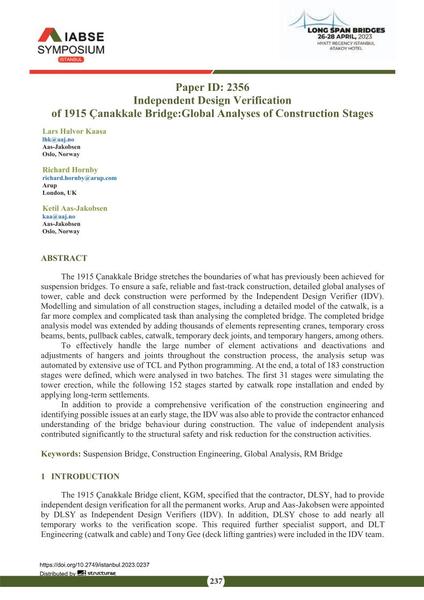Independent Design Verification of 1915 Çanakkale Bridge:Global Analyses of Construction Stages

|
|
|||||||||||
Bibliographic Details
| Author(s): |
Lars Halvor Kaasa
(Aas-Jakobsen Oslo, Norway)
Richard Hornby (Arup, London, UK) Ketil Aas-Jakobsen (Aas-Jakobsen Oslo, Norway) |
||||
|---|---|---|---|---|---|
| Medium: | conference paper | ||||
| Language(s): | English | ||||
| Conference: | IABSE Symposium: Long Span Bridges, Istanbul, Turkey, 26-28 April 2023 | ||||
| Published in: | IABSE Symposium Istanbul 2023 | ||||
|
|||||
| Page(s): | 237-244 | ||||
| Total no. of pages: | 8 | ||||
| Year: | 2023 | ||||
| DOI: | 10.2749/istanbul.2023.0237 | ||||
| Abstract: |
The 1915 Çanakkale Bridge stretches the boundaries of what has previously been achieved for suspension bridges. To ensure a safe, reliable and fast-track construction, detailed global analyses of tower, cable and deck construction were performed by the Independent Design Verifier (IDV). Modelling and simulation of all construction stages, including a detailed model of the catwalk, is a far more complex and complicated task than analysing the completed bridge. The completed bridge analysis model was extended by adding thousands of elements representing cranes, temporary cross beams, bents, pullback cables, catwalk, temporary deck joints, and temporary hangers, among others. To effectively handle the large number of element activations and deactivations and adjustments of hangers and joints throughout the construction process, the analysis setup was automated by extensive use of TCL and Python programming. At the end, a total of 183 construction stages were defined, which were analysed in two batches. The first 31 stages were simulating the tower erection, while the following 152 stages started by catwalk rope installation and ended by applying long-term settlements. In addition to provide a comprehensive verification of the construction engineering and identifying possible issues at an early stage, the IDV was also able to provide the contractor enhanced understanding of the bridge behaviour during construction. The value of independent analysis contributed significantly to the structural safety and risk reduction for the construction activities. |
||||
| Keywords: |
suspension bridge global analysis construction engineering RM Bridge
|
||||
